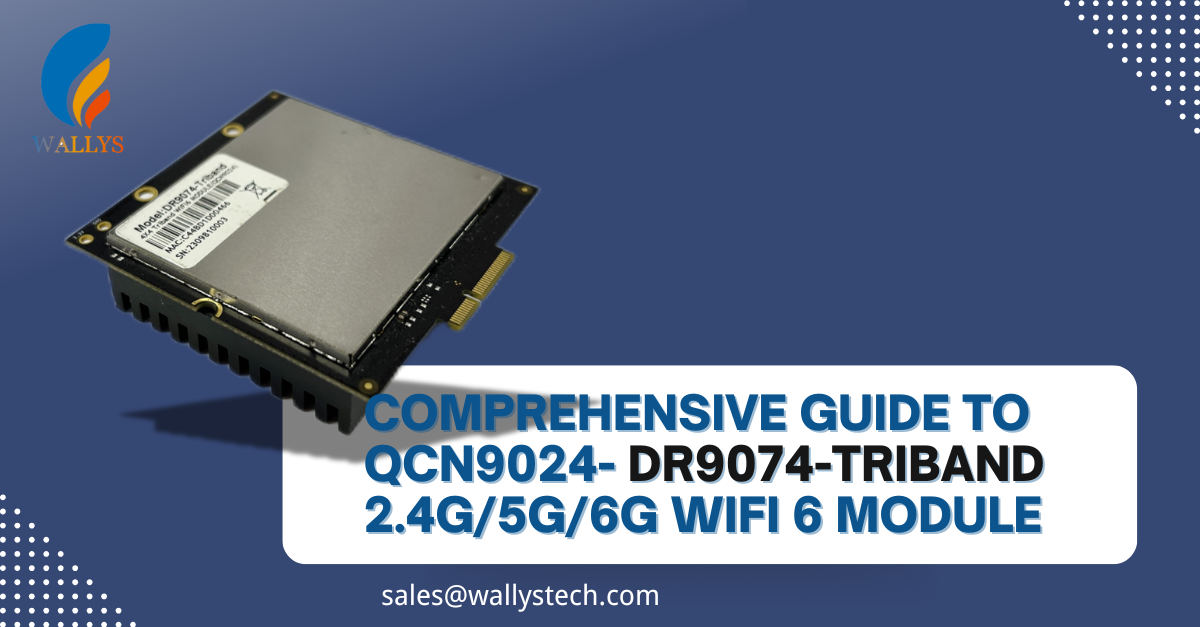Between QCN9074 and QCN9024 in Tri-Band Module Design Exploring the Differences

In wireless communication products, the chip architecture directly determines the application scenarios and product forms. Recently, industry discussions have focused on why Qualcomm’s QCN9074 can be developed into Wi‑Fi6 modules that support single 5GHz or single 6GHz operation, yet it cannot be manufactured into modules that support tri-band operation (simultaneously supporting 2.4GHz, 5GHz, and 6GHz), whereas the QCN9024 chip can be designed for tri-band modules. This article provides a comprehensive analysis from the perspectives of architectural design, RF front-end integration, firmware calibration, and market positioning.
1. Chip Architecture and Design Orientation
Positioning of QCN9074:
The QCN9074 was designed primarily for high-performance Wi‑Fi6 applications. Its internal architecture and RF transceiver layout are optimized for operation in a single frequency band (either 5GHz or 6GHz). While it is engineered for high-speed, low-latency data transmission, this also means that it does not allocate sufficient resources or interfaces for handling simultaneous multi-band signal switching and independent transmission.
Advantages of QCN9024:
In contrast, the QCN9024 has a more flexible architecture design, supporting simultaneous multi-band operation (typically including 2.4GHz and 5GHz, and in some designs even covering 6GHz). This is due to the fact that its RF front-end and digital signal processing units have reserved interfaces, allowing the chip—when paired with external RF components (such as filters, switches, and power amplifiers)—to achieve comprehensive tri-band support.
2. RF Front-End Integration and Signal Path Design
Allocation of RF Resources:
Wireless modules that support tri-band operation require multiple independent signal paths in the RF front-end, including several sets of filters, low-noise amplifiers (LNA), power amplifiers, and corresponding RF switches. In the QCN9074, the internal paths and interfaces are primarily optimized for single-band performance. To support tri-band operation, additional RF resources and more complex signal path switching circuits would be necessary—posing significant challenges in chip packaging and cost control.
Advantages of QCN9024:
On the other hand, the QCN9024 was designed from the outset with multi-band coexistence in mind. Its internal signal processing and interface planning reserve sufficient expandability, allowing the use of an external RF network to more easily achieve coordinated operation in the 2.4GHz, 5GHz, and even 6GHz bands. This design makes it possible for QCN9024 to be applied in tri-band modules that provide broader spectrum coverage.
3. Firmware Support and Calibration Algorithms
Calibration Complexity: Single-Band vs. Multi-Band:
The performance of wireless modules depends not only on hardware design but also on firmware algorithms and calibration procedures. Calibration for single-band modules is relatively straightforward, as the firmware only needs to optimize for one frequency band. In contrast, tri-band modules require precise power control, frequency calibration, and dynamic spectrum allocation across multiple bands, which places higher demands on the chip’s internal control algorithms.
Maturity and Support:
The QCN9074’s firmware and calibration solutions are focused on single-band applications, meaning they do not offer mature optimizations for the complex scenarios of multi-band operation. In contrast, the QCN9024 was developed with multi-band scenarios in mind, and its accompanying firmware and calibration algorithms are already mature enough to support stable switching and efficient transmission across multiple bands.
4. Market Positioning and Product Strategy
Different Target Markets:
From a market strategy perspective, the QCN9074 is primarily aimed at applications that require extremely high performance and low latency in a fixed frequency band (such as high-performance wireless cards or specialized devices). These products prioritize ultimate performance and do not need to cover multiple bands simultaneously.
Meanwhile, the QCN9024 is positioned for a broader range of consumer and enterprise products, such as tri-band home or business routers. Its multi-band design meets the need for flexible operation in environments with varying interference conditions across different frequency bands.
5. Conclusion
In summary, the inability of the QCN9074 to be designed as a tri-band module is mainly due to:
Chip Architecture Orientation: Its internal resources and design philosophy are optimized for single high-frequency operation.
RF Front-End Design: It lacks sufficient interfaces and signal paths to simultaneously handle tri-band signals.
Firmware and Calibration Support: It does not provide mature algorithms for the complex scenarios required by multi-band operation.
Market Strategy Considerations: It is tailored for specific high-performance single-band applications.
In contrast, the QCN9024 was designed from the beginning with multi-band operation in mind. Through more flexible RF interface design and mature software calibration solutions, it can support tri-band modules that cover 2.4GHz, 5GHz, and, in some cases, parts of the 6GHz band, thereby adapting to a wider range of application scenarios.
Understanding the different chip design philosophies and application requirements is crucial for R&D engineers and product designers when selecting components.










评论